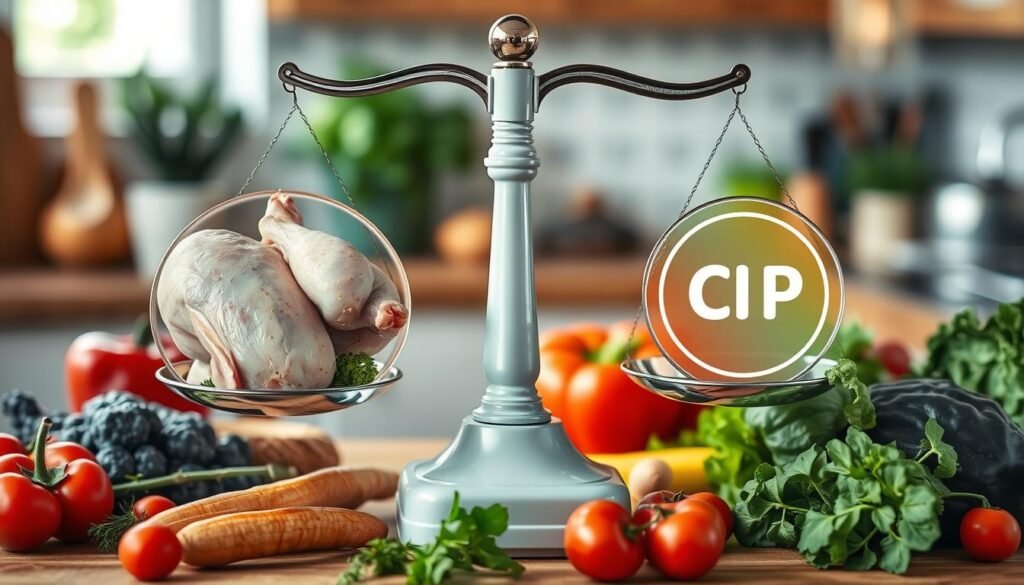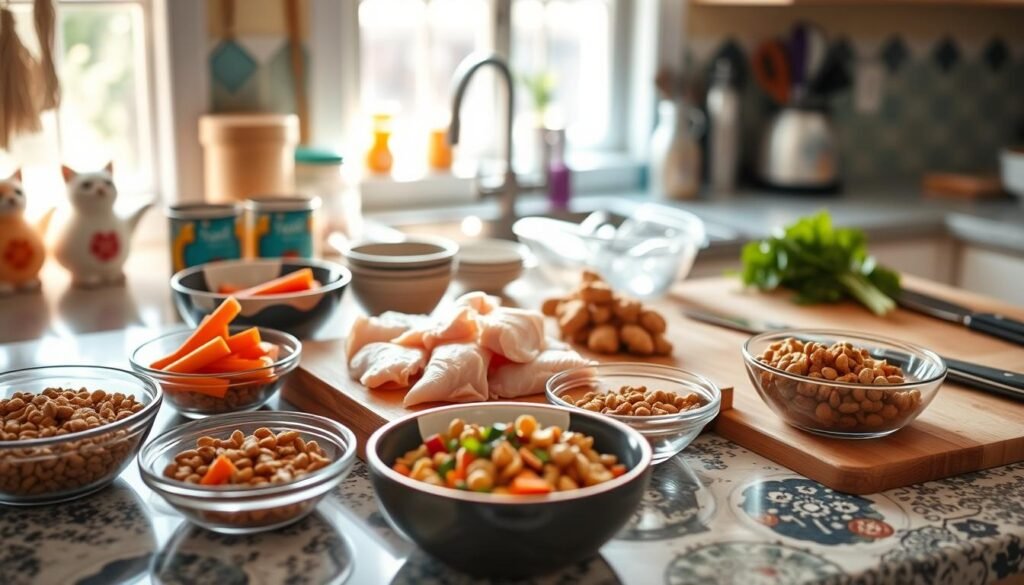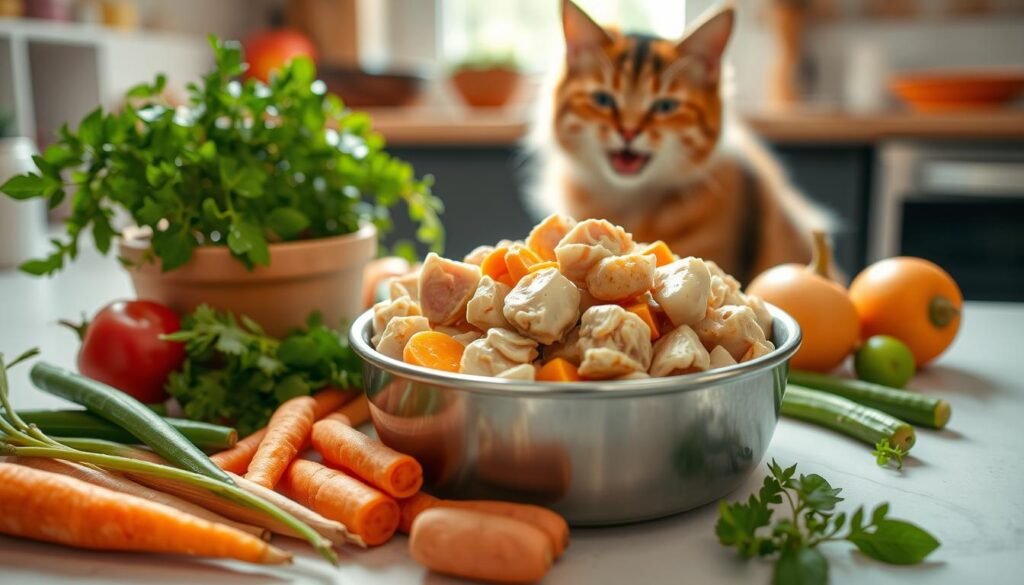Did you know cats can eat up to 15 times their body weight in food each year1? This fact makes many pet owners look for healthier food options for their cats. Making homemade cat food can improve your cat’s health and give them a shiny coat. But, it might seem hard to make a balanced meal from scratch.
In this article, we’ll show you how to make a tasty chicken-based homemade cat food. It’s easy to prepare and meets your cat’s dietary needs.
Key Takeaways
- Homemade cat food lets you control what goes into it, avoiding bad stuff in commercial foods1.
- Barley is great for homemade cat food, adding fiber, protein, and vitamins for better health1.
- Cats can be picky, and many don’t like certain foods1.
- The homemade chicken cat food recipe needs 2lbs (900g) of meat for a 3lb serving2.
- Kittens can start eating raw or cooked meat at 4 weeks old. They should eat four times a day until they’re 4 months old. Then, they eat three times a day until they’re 12 months old2.
Introduction to Homemade Cat Food
Switching to homemade cat food can be very rewarding. You can make meals that fit your cat’s needs with fresh, quality natural ingredients for pets. This can improve your cat’s health, making their digestion better, their coat shinier, and their energy levels higher3.
Benefits of Homemade Cat Food
Homemade cat food lets you avoid bad stuff like fillers and preservatives. You can make sure your cat gets the right mix of nutrients. This leads to better health and a balanced diet for your cat3.
Challenges of Making Homemade Cat Food
Homemade cat food has its ups and downs. It’s hard to make sure it’s balanced and safe. You need to know a lot about what cats need to eat. Also, handling raw meat safely is key to avoid sickness3.
“Making homemade cat food eliminates the need to purchase 182.5 cans per year.”3
| Cost Comparison | Homemade Cat Food | Fancy Feast |
|---|---|---|
| Cost per Year | $47.45 | $104.03 |
| Cost per 3 oz Can | – | $0.57 |
Homemade cat food costs about $47.45 a year. Fancy Feast costs $104.03. Also, a big pack of chicken thighs can make a lot of cat food. A double batch can last 7 weeks4.
Preparing and Handling Raw Meat Safely
When making homemade cat food, it’s key to handle raw meat safely to avoid foodborne illnesses. We clean our work area, pick fresh, quality meat, and thaw it in the fridge, not at room temperature. Wearing food-grade gloves helps reduce contact with raw ingredients5.
It’s also vital to portion and freeze the food right away. Discard any leftovers that have been out for over 30 minutes. Using the right storage and handling techniques keeps our homemade cat food safe and ready6.
To keep our cats safe, we take careful steps when handling raw meat for homemade pet food preparation. We wash our hands, pet bowls, and surfaces. This keeps the feeding area clean and safe, just like for human food7.
“Proper preparation and handling of raw ingredients are essential for the safety and health of our pets.”
Following these best practices makes sure our homemade cat food is both nutritious and safe for our pets to eat567.
| Ingredient | Quantity |
|---|---|
| Chicken Thighs | 3 kg |
| Chicken Hearts | 900 g |
| Chicken Liver | 300 g |
Understanding a Cat’s Digestive System
Cats are obligate carnivores, meaning their digestive system is made for animal-based nutrients8. Their shorter, more acidic digestive tract and increased bile production help them digest raw meat well8. Raw meat is more digestible for cats than cooked meat because cooking can damage some nutrients8. Knowing how a cat’s digestive system works is important when switching to a homemade raw diet.
Cats as Obligate Carnivores
Cats are built to eat raw meat, with their bodies needing animal-based proteins and fats8. Their stomach’s acidity and more bile help break down and absorb raw nutrients8. This efficient digestion is why a homemade raw diet is good for cats, as it’s similar to their natural diet.
Digesting Raw Food
The right calcium to phosphorus ratio for homemade cat food is 1.1:1, but it can vary8. Raw meat is better for cats than cooked meat, studies show8. A homemade raw cat food recipe includes 4.5 lbs of chicken with bone, 7 ounces of raw chicken liver, 14 ounces of raw chicken hearts, 4 egg yolks, and supplements like taurine and vitamin E8.
When preparing raw meat for cat food, it’s important to sanitize surfaces and use gloves8. Freeze or refrigerate meat quickly and wash and sanitize all tools used8. To figure out how much food to make, calculate daily portions per cat, then multiply by the number of cats and days in a month8.
Balancing Calcium and Phosphorus Ratio
When making homemade cat food, it’s key to get the calcium to phosphorus (Ca:P) ratio right9. The best ratio for your cat’s bones is between 1.0 to 1.3 parts of calcium for every 1 part of phosphorus9. To hit this mark, add about 3 grams of eggshell powder to one pound of raw meat without bones9.
Cats need a diet rich in protein and low in carbs10. Homemade cat food recipes might vary in supplements, but that doesn’t mean they’re lacking compared to store-bought mixes10. Diets that include whole meats, bones, and organs don’t need extra supplements10. But, for meat-only diets, adding calcium is vital because meat lacks it10.
Keeping the Ca:P ratio in check is vital for your cat’s bone health and overall health9. Without enough calcium, cats might face growth problems, bone issues, lameness, or seizures9. Too much calcium, though, can cause stomach upset, vomiting, or fever in cats9.
| Nutrient | Ideal Ratio | Why It Matters |
|---|---|---|
| Calcium (Ca) | 1.0 to 1.3 parts | Supports bone development and maintenance |
| Phosphorus (P) | 1 part | Contributes to bone health, but excess can cause issues |
Getting the calcium and phosphorus balance right is essential for your cat’s health910. By knowing the ideal Ca:P ratio and adding the right supplements, you can make sure your homemade cat food has all the nutrients your cat needs910.

chicken cat food recipe
Our homemade chicken cat food recipe is a mix of top-notch, natural ingredients. It meets your cat’s special nutritional needs11. It’s a healthy, homemade choice instead of store-bought pet food. Your cat will get all the vitamins, minerals, and nutrients they need for health and happiness.
Ingredients
- 4.5 lbs of Chicken Ground with the Bone-In (raw)
- 7 oz of Raw Chicken Liver
- 14 oz of Raw Chicken Hearts
- 8 oz of Drinking Water
- 4 Egg Yolks
- 2000 mg Taurine
- 4000 mg Salmon or Krill Oil
- 200 IU Vitamin E
- 200 mg B-Complex
- 1.5 tsp Lite Iodized Salt
- 4 tsp Psyllium Husk Powder (optional)
Instructions
- Mix all the ingredients in a big bowl. Make sure the supplements are spread out evenly11.
- Divide the food into portions and freeze for easy meal prep12.
- Thaw the portions in the fridge the night before.
- Warm the food a bit before serving. Cats like it warm.
- Throw away any food left out for over 30 minutes.
With this homemade chicken cat food recipe, you can give your cat a tasty, healthy meal. You’ll know exactly what’s in their food. This gives you peace of mind and lets you offer a natural, homemade option instead of store-bought food.
Scheduling and Meal Prepping
To make sure your cat gets the right amount of homemade food, you need to figure out their daily needs. Use online tools like the Feline Nutrition Foundation’s calculator to find out how much they should eat based on their weight and activity level13. Then, multiply that amount by 30 to plan for a month’s meals. This makes preparing their food easier and more organized.
Having a set schedule for buying ingredients and making food helps a lot. Start by marking when you’ll need to make more food on your calendar. Then, order the meat, organs, and supplements a couple of weeks early so they arrive on time13. On the day you make the food, get all your ingredients ready. Follow the recipe to mix, portion, and freeze the food. This routine makes giving your cat homemade food easy and stress-free.
Calculating Portions
Figuring out how much food your cat needs depends on their weight and how active they are. Use online tools, like the Feline Nutrition Foundation’s, to find out the right daily amount13. Then, just multiply that by 30 to plan for a month’s worth of food. This way, you’ll always have enough homemade food ready.
Ordering and Preparation Routine
Having a regular routine for buying and making your cat’s food makes things easier. First, note when you’ll need to make more food on your calendar. Then, order the meat, organs, and supplements a couple of weeks early so they arrive on time13. On the day you make the food, get all your ingredients ready. Follow the recipe to mix, portion, and freeze the food. This routine makes giving your cat homemade food easy and stress-free.
“Meal prepping for your cat’s homemade food can save you time and ensure your feline friend gets the balanced nutrition they need.”
Always talk to your vet before changing your cat’s diet, even if it’s just to homemade food13.
Supplementing for Complete Nutrition
Homemade cat food recipes offer many benefits. But, it’s key to make sure the diet is complete and balanced. This can be done by adding the right supplements. Premix supplements, made by vet nutritionists, help fill any nutritional gaps14.
These premixes are mixed with fresh meat to create a balanced meal for your cat14.
Homemade Diet Premix Supplements
When picking a premix, look for one that meets AAFCO or FEDIAF standards. Consider your cat’s specific dietary needs. A high-quality premix ensures your homemade cat food meets all nutritional needs14.
The homemade cat food mix with Chicken Liver Powder has essential nutrients like protein, fat, and vitamins14. The mix without Poultry Protein also has important nutrients14.
Recommended Omega-3 oils include Superior Feline Wild Anchovy and Virgin Chia Seed Oil14. Each bag makes about 20 lbs of food14. There’s a Trial Size option and Free Shipping on orders over $3514. The packaging is compostable and certified14.
Using a premix has its pros and cons15. It ensures a balanced diet, but may lack recipe precision15. It can be more expensive than homemade diets15.
When using a meal completer, add fish oil and a fiber source15. Aim for 30% to 45% of calories from fat15. Different meal completers have different dosages15.
Sample Homemade Cat Food Recipes
There are many homemade cat food recipes to try, aside from the chicken-based one in this article. You can make a turkey and sweet potato recipe, a cooked meat dish with a premix supplement, or a raw ground rabbit recipe with a special premix16. Each recipe is tasty and healthy, with the right supplements for your cat’s well-being16.
Before switching to homemade food, talk to your vet. They can help make the transition smooth. Experts suggest starting with a little raw food mixed into your cat’s usual diet. Then, slowly add more raw food until your cat eats only homemade food16.
Homemade cat food is better than store-bought because it’s natural and cheaper. It avoids bad ingredients and high prices found in commercial food16. By making your cat’s food, you ensure they get the best nutrition from whole animals, just like nature intended16.
Vet-Approved Homemade Cat Food Recipes
Here are some vet-approved homemade cat food recipes to try:
- Turkey and Sweet Potato Recipe: Includes baked, shredded turkey, steamed broccoli, raw carrots, canola oil, and Omega-3 Pet Liquid17.
- Cooked Meat Recipe with Premix Supplement: Features cooked chicken, Balance IT® Feline supplement, cooked quinoa, and pumpkin puree17.
- Raw Ground Rabbit Recipe with Specialized Premix: Combines raw ground rabbit, Balance IT® Carnivore blend, egg, cottage cheese, olive oil, and turmeric17.
When making homemade cat food, follow the recipe’s instructions carefully. Also, always check with your vet to make sure your cat’s diet is right17.

“Providing your cat with a varied and nutritious homemade diet can be a rewarding experience for both you and your feline companion.”
Transitioning to Homemade Cat Food
Switching your cat to homemade food needs to be done slowly18. Begin by adding a little homemade food to their current food. Gradually increase the homemade food over weeks18. This helps their body adjust without upsetting their stomach18.
Watch how your cat reacts to the change19. Some cats might not like certain foods in commercial foods. A homemade diet can help19. If they get sick from kibble, homemade might be better19.
Make sure your homemade food is good for your cat. Look online or talk to experts19. Sites like cuisine-a-crocs.com and thelittlecarnivore.com have vet-approved recipes19.
With patience and the right help, you can make your cat’s diet better18. Keep an eye on how they do and adjust as needed18.
Monitoring Your Cat’s Health
When you switch your cat to homemade food, watch their health closely. Look for signs like more energy, a shiny coat, and better digestion. These show the food is good for them20. Also, notice any changes in their behavior, appetite, or bathroom habits. These could mean there’s a problem21.
If you’re worried about your cat’s health, talk to your vet. They can check if the food is right for your cat’s needs21.
Take your cat to the vet every two to three months if they eat homemade food21. This lets the vet check on your cat and make diet changes if needed. Keeping in touch with your vet is important for your cat’s health and happiness.

Start slowly with homemade food to avoid stomach problems21. Use vet-approved recipes that are balanced and complete21. With careful planning and watching, you can give your cat food that’s good for their health and happiness202122.
Conclusion
Switching your cat to homemade food can be very rewarding. It offers many health benefits and lets you customize their meals. By knowing what cats need and how to prepare it, we can make food that keeps them healthy and happy23.
With the right recipe and care, we can give our cats a diet that’s good for them. This diet supports their health and happiness for a long time.
Experts say mixing raw and cooked homemade food is safer and healthier than dry food23. Homemade cat food made right is better than unbalanced homemade diets or commercial canned food23. It’s also good for cats with health issues like allergies and diabetes24.
By focusing on safety and convenience in making homemade cat food, we can give our cats the best meals23. This dedication to their nutrition supports their health and happiness for a long time24.
FAQ
What are the benefits of homemade cat food?
What are the challenges of making homemade cat food?
How do you properly handle and prepare raw meat for homemade cat food?
Why are cats considered obligate carnivores?
What is the ideal calcium-to-phosphorus ratio for homemade cat food?
What are the key ingredients in the homemade chicken cat food recipe?
How do you calculate the portion size for homemade cat food?
What is the importance of using a homemade diet premix supplement?
How do you transition your cat to a homemade diet?
How do you monitor your cat’s health on a homemade diet?
Source Links
- Homemade Food for Cats: Simple, Quick, and Healthy Recipe – https://cats-magazine.com/cat-food/the-purr-fect-guide-to-homemade-food-for-cats-easy-quick-and-yummy-recipe-beefy-barley-delight/
- How to Make Homemade Cat Food – https://www.knowbetterpetfood.com/blogs/blog/how-to-make-homemade-cat-food?srsltid=AfmBOoqRnKJqPZGaiqptID6zFyWSrYJlDV4YHLqhMMjiq0UanILxxL2_
- Making Homemade Cat Food–Save Money AND Make Your Cat Happy! – https://steemit.com/homesteading/@mtnmeadowmomma/making-homemade-cat-food-save-money-and-make-your-cat-happy
- Feline Nutrition – Feline Nutrition’s Easy Homemade Cat Food Recipe – https://hare-today.com/feline-nutrition/nutrition/making-raw-cat-food-for-do-it-yourselfers
- Raw Cat Food Recipe | Meow Lifestyle – https://meowlifestyle.com/raw-cat-food-recipe/
- Raw Cat Food Recipe – Keto Kitties with Allergies – Have Butter Will Travel – https://havebutterwilltravel.com/keto-cat-raw-food-recipe/comment-page-1/
- Frozen Raw Cat Food Chicken Recipe – https://stevesrealfood.com/raw-cat-food/frozen-chicken-diet/
- Homemade Cat Food: Feeding Your Cat for Optimal Health and Longevity – https://furraticbehavior.com/homemade-cat-food-the-art-of-feeding-your-cat-for-optimal-health-and-longevity/
- Feline Nutrition – Calcium Supplements in Homemade Cat Food – https://hare-today.com/feline-nutrition/nutrition/the-importance-of-calcium-supplements-in-homemade-cat-food
- Feline Nutrition – Homemade Cat Food, a Balancing Act – https://hare-today.com/feline-nutrition/nutrition/homemade-cat-food-a-balancing-act
- Seeking Easy Chicken-Based Cat Food Recipe 🙂 – https://thecatsite.com/threads/seeking-easy-chicken-based-cat-food-recipe.464959/
- Chicken Recipe for Cats | The Nosh Project – https://thenoshproject.com.au/recipes/cat-chicken-rice-bowl/
- Creating a Meal Plan for Your Dog and Cat | Red Dog Blue Kat | Red Dog Blue Kat – https://www.reddogbluekat.com/post/meal-planning-for-your-dog-and-cat
- Homemade Cat Food Supplement Mix — Superior Feline – https://www.superiorfeline.com/shop/p/homemade-cat-food-supplement-mix
- Meal completers for your cat’s homemade diet — The Little Carnivore – https://thelittlecarnivore.com/en/blog/meal-completers-for-your-cats-homemade-diet
- Raw Homemade Kitten and Cat Food Recipe (all meat) – https://healthhomeandhappiness.com/raw-homemade-kitten-and-cat-food-recipe-all-meat.html
- How to Cook Chicken for Cats: 5 Vet-Approved Recipes – Catster – https://www.catster.com/nutrition/how-to-cook-chicken-for-cats/
- Vet Approved Homemade Cat Food Recipes: Chicken and Pumpkin – https://www.spunkyjunky.com/blogs/weekly-recipe-homemade-pet-food/vet-approved-homemade-cat-food-recipes-chicken-and-pumpkin
- Homemade cat food – https://thecatsite.com/threads/homemade-cat-food.463254/
- How to Make Homemade Cat Food – https://www.knowbetterpetfood.com/blogs/blog/how-to-make-homemade-cat-food?srsltid=AfmBOoro-fYIbA6T5cOrpZXmS6BDfp5dx6nmNK3RKwsO9Tguxp217M3H
- Is Homemade Cat Food Better? – https://www.petmd.com/cat/nutrition/homemade-cat-food-better
- Cat Food Recipe | Dr. Michael W. Fox – https://drfoxonehealth.com/post/cat-food-recipe/
- Making Cat Food – https://catinfo.org/making-cat-food/
- The Complete Guide to Making Homemade Cat Food – Cats.com – https://cats.com/making-cat-food-homemade
